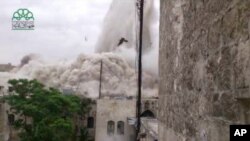Syrian government forces have increased the tempo of air raids on rebel-held territory, striking combatants and civilians in what analysts and U.S. officials say is an apparent attempt to gain ground while the U.S.-led coalition strikes Islamic State group targets in Syria.
In the past 10 days alone, the Syrian air force has conducted 762 airstrikes, according to the Syrian Observatory for Human Rights, a British-based pro-opposition monitoring group that gathers information from a network of activists inside war-wracked Syria.
The strikes included a raid on a displaced-persons camp Wednesday in the northern Syrian province of Idlib, which has been the scene of recent heavy fighting between rebels and forces loyal to Syrian President Bashar al-Assad. At least 10 people were reported killed and many more wounded.
The makeshift camp mainly housed civilians who had fled from Hama, one of several Syrian provinces that have witnessed almost daily raids from Assad government warplanes.
The attack drew a sharp response from U.S. State Department spokeswoman Jen Psaki, who described the raid as “nothing short of barbaric.” She told Reuters news agency: “If it is confirmed to be the work of the [Assad] regime, it is only the latest act of brutality by the regime against its own people.”
U.S. Defense Secretary Chuck Hagel said Thursday that Assad seems to be taking advantage of the American-led airstrikes against the Islamic State group, using the coalition’s air offensive as an opportunity to increase his own air assaults on opponents.
Hagel said Assad “derives some benefit” from the U.S. intervention, which is aimed at the jihadists who have captured a huge swath of eastern Syria and western Iraq.
Since the start of the U.S. airstrikes against the Islamic State in both Iraq and Syria, rebel commanders have warned that Assad would see the American intervention as a green light to increase the ferocity of his own air offensive against his opponents.
Abu Muhammad, a moderate Islamist insurgent commander, told VOA the Syrian president realigned his forces once the coalition airstrikes began — shifting some troops from eastern Syria to reinforce his offensive against moderate and Islamist rebels in the key city of Aleppo, and to strengthen his defense of the town of Idlib, to the west.
Since early October, the pace of Syrian government air raids has jumped. Of 762 airstrikes since October 20, the Syrian Observatory claims nearly half (354) involved helicopters dropping so-called barrel bombs — unsophisticated but deadly improvised weapons consisting of explosives packed into canisters or oil drums and topped off with fuel and metal shards.
Without any guidance system, the bombs are simply rolled out of helicopters as the aircraft pass over presumed rebel positions. Analyst Richard Lloyd, a technology consultant, has dubbed the barrel bomb a perfect terror weapon — a cost-effective way of striking at built-up areas and sowing dread by killing arbitrarily.
“The main objective of the Syrian barrel bomb program is to provide cheap and lethal damage,” Lloyd wrote last year in a study of their impact.
Assad regime warplanes have focused on strategic targets such as the portion of Aleppo still held by rebels despite a major government offensive aimed at their supply lines.
In an assessment last week for a Washington-based think tank, the Center for Strategic and International Studies, security analyst Anthony Cordesman warned: “The Assad forces are using the U.S. and allied campaign against the Islamic State to make a massive step-up in air attacks on other rebels.”
According to opposition activists, no fewer than 221 civilians — 69 children and 47 women among them — have died during the past 10 days of Syrian government airstrikes. Estimates are that more than 500 others were wounded. The activists rail on the foreign media's focus on the battle for the Syrian border town of Kobani and the U.S. air offensive aimed at lifting the siege of the mainly Kurdish town, saying it has distracted political attention from what is happening elsewhere in Syria.
The Syrian Observatory is urging the United Nations to refer the Assad air offensive to the International Criminal Court for an investigation into possible crimes against humanity.
Abdul Rahman, a commander with the moderate Islamist Army of Mujahedeen, said the U.S. should focus as much on Assad as the Islamic State. “We have to look both ways — fighting the jihadists and Assad,” he says.
In the past 10 days Assad’s air forces have unleashed an average of 76 bombing runs a day. Since the U.S. and its coalition partners launched their air war against the Islamic State fighters, the most airstrikes in any 24-hour stretch has been 23. Pentagon officials say those raids on October 25-26 concentrated on Kobani.
Overall, the U.S.-led coalition has launched fewer than 300 airstrikes, according to a tally of daily situation reports issued by the Pentagon.
According to reports by Reuters, U.S.-led airstrikes hit Islamic State positions around the Syrian border town of Kobani on Friday in an apparent bid to pave the way for heavily armed Iraqi Kurdish peshmerga forces to enter from neighboring Turkey.
The predominantly Kurdish town, besieged for more than 40 days, has become the focus of a global war against the Sunni Muslim insurgents, who have captured expanses of Iraq and Syria and declared an Islamic “caliphate” straddling the two.
Portions of this news report are from Reuters.







